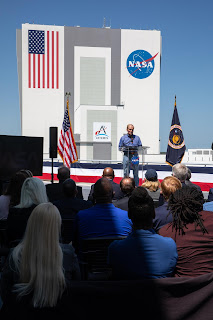Remember when China denied they would militarize the fake "islands" they dredged up in violation of the Law of the Sea Treaty? In 2015, Chinese dictator Xi Jinping pledged “China does not intend to pursue militarization” of the Spratly Islands in the South China Sea. Of course, that's exactly what they did, building extensive military bases all across the sea.
Fast forward to last week, when China's foreign minister objected to NASA Administrator Bill Nelson calling out the Chinese regime for having similar plans to claim key areas of the moon, which would be in violation of the Outer Space Treaty.
This is no secret, in fact, they have boasted they would claim the Moon and Mars. In 2017, the head of China's lunar program, Ye Peijian, compared the Moon and Mars to islands they are trying to illegally seize in the South and East China Seas:
The universe is like the ocean, the moon is like the Diaoyu Islands, and Mars is like Huangyan Island.
The "Diaoyu Islands" are in fact Japan's sovereign Senkaku Islands. "Huangyan Island" is in fact the Philippines’ sovereign Scarborough Shoal, which China seized and completely militarized in violation of the Law of the Sea Treaty.
So when China's government objects to Nelson stating what everyone knows and what Ye Peijian described so poetically, it's like the criminal pointing at an innocent person and shouting, "there's the thief!" That's called "projection" or "mirroring," and it's a staple of Chinese Communist Party propaganda.
Back to Bill Nelson. He just warned what everyone in defense and space policy knows. That China is instigating a “new race to space” with the long-term goal of “tak[ing] over” the moon.
“We must be very concerned that China is landing on the moon and saying, ‘It’s ours now and you stay out,’” He continued, describing the Chinese space program for what it is, a military agency dedicated to establishing military control of space. "China's space program is a military space program," where they are learning "how to destroy other people's satellites," and that the south pole of the moon is "hotly contested."
The new CCP space station is not like ours, it's a military post for developing space weapons and espionage. Ever seen a real photo of the complete station? We show off thousands of photos of ISS, but China won't release more than a few, very limited angles, raising the suspicions they are hiding spy equipment and perhaps even weapons. That wouldn't be a new idea. After all, the Soviet Almaz space station was armed with a 14.5mm cannon (5,000 rounds per minute!) and espionage equipment.
What does this verbal exchange mean? America and our allies had better light the rockets under everyone and accelerate our return to the Moon. 2025 may be almost too late. China has an unlimited budget and no political fights. 2026, 2027 or 2028 may see a Chinese flag and "keep out" signs on the water-ice bearing craters on the lunar south pole.
That means Bill Nelson needs to ask Congress for the funds to accelerate everything. SLS, lander (SpaceX's Starship), spacesuits, and everything else needed to have 'boots on the ground' on the Moon by early 2025. Go to three shifts if that's what it takes. If necessary, cancel or delay the Gateway to shift that funding to getting to the Moon absent the Gateway. Consider bypassing SLS if it's running behind and go entirely on SpaceX spacecrafts.
Just keep in mind that we are in a struggle between the free world having civilian and commercial access to orbital and cis-lunar space and to the surfaces of the Moon and Mars, or a dark future where access is either denied outright, or allowed only as per current Chinese commercial rules (in violation of WTO) that require a 51% Chinese partner (often associated with the government or military), surrendering all of a company's technology, and remaining silent on human rights and labor abuses in China.
Our mere presence on the Moon will help restrain Xi's worst instincts. Ready? Let's go!
(Photo credit NASA)










